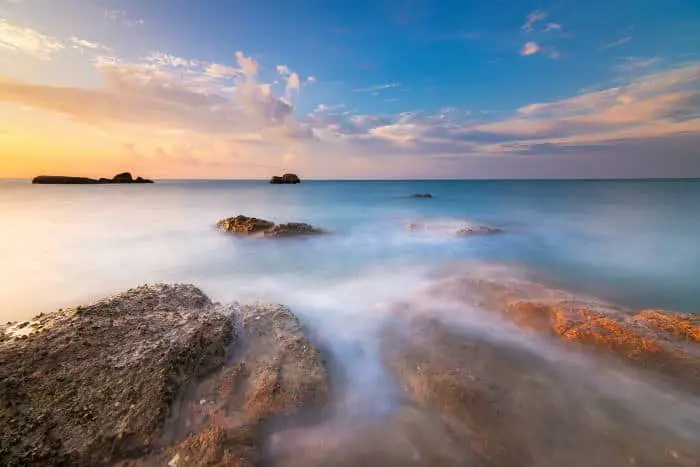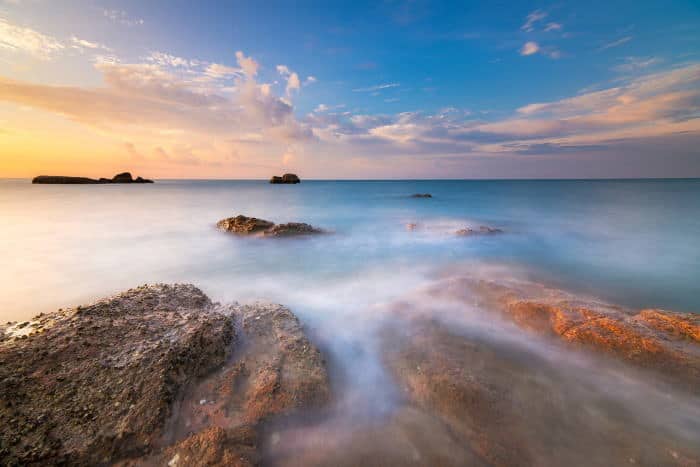- You are here:
- Home »
- Blog »
- Dive Deeper »
- Freediving at High Altitude: Risks, Tips and a Quick Breakdown
Freediving at High Altitude: Risks, Tips and a Quick Breakdown


Most people freedive at low altitudes near sea level, but venturing out to bodies of water at higher altitudes can offer new sights, stunning terrains, and brand-new challenges. High-altitude freediving follows different rules than sea-level diving, which could make it more dangerous.
Please note: this post is not medical advice. I recommend always consulting with a doctor or health professional before diving at high altitude or making any significant changes to your freediving routine.
When freediving at high altitudes above 300 m (1,000 ft) from sea level, you must use different dive tables and decompression times to avoid altitude and decompression sickness. You should also allow yourself plenty of time to acclimate to atmospheric pressure.
So, let’s get down to the details and talk about what makes high-altitude freediving different from sea-level freediving. I’ll tell you about the precautions you might need to take at high elevations, and I’ll give you some tips to avoid injury and illness.
What Is Considered High-Altitude Diving?
Naturally, high-up places have a more substantial altitude. However, high-altitude diving meets some specific criteria.
High altitude diving is diving at more than 300 m (1000 ft) above sea level. However, you don’t necessarily have to be on a mountain to be at a high altitude. As a general rule, if you’re not freediving in the ocean, the chances are that you are technically diving into a high-altitude body of water.
For example, even most of the great plains region of the USA qualifies as high altitude under this definition.
Still, the higher up you are, the harder it will be to freedive.
Altitude will start to impact your freediving at only 300 meters (1,000 ft). That’s because, at this level of elevation, the atmospheric pressure is 0.96 ATM.
So, it is usually best to understand the elevation of any area before you get into the water. That way, you can adjust to the pressure and other conditions of the body of water you will be diving in.
How Do High Altitudes Affect Freediving?
When freediving at any location, it is crucial to understand your limits. Still, at high altitudes, the times and pressures that you are accustomed to won’t always be appropriate.
High altitudes will affect your freediving since you will need to consider the lessened oxygen in the atmosphere, the lower atmospheric pressure, your residual nitrogen levels, and the water density.
Neglecting to take your dive spot’s peculiarities, especially its altitude, into account can result in severe consequences, so let’s talk about the things you need to keep in mind before your high-altitude dives.
There Is Less Oxygen in the Atmosphere
At high elevations, it is harder to breathe in the oxygen you need to stay alive. That’s because, at high altitudes, the amount of oxygen in the atmosphere drops to between 90 and 65%, making it challenging for your body to extract it from the air.
Traveling to locations with an elevation of 2,500 meters (8202 ft) too quickly could give you hypoxia, also called “the altitude bends” or altitude sickness.
This condition, much like decompression sickness in diving, can result in joint pain, lung collapse, internal bleeding hyperventilation, or more severe complications.
Freediving before your body acclimates to the low-pressure environment could give you the other type of bends, too, which can be fatal if they co-exist.
So, to stay safe, you will probably want to allow a few days for your body to acclimate to the atmospheric pressure in high-altitude environments before you even consider freediving.

The Atmospheric Pressure Is Lower, but the Water Pressure Is the Same
Diving at high altitudes often makes decompression more difficult since the atmospheric pressure is lower, but the water pressure is the same. So, what does that have to do with anything? Let’s talk about it.
ATM levels play a significant role in the amount of time it takes for you to adjust to the water’s pressure and the amount of time it will take to decompress after a dive. So, when diving at high altitudes, you will need to use different diving tables.
When freediving below sea level, the atmospheric pressure is higher, usually falling around 1 ATM. So, when you start to dive down, your body can adjust to the water pressure pretty quickly since it’s not all that different from the atmospheric pressure.
However, at high altitudes, where the atmospheric pressure is lower than 1 ATM, your body will have a more challenging time adjusting to the water pressure. You will also need to ascend more slowly since you have a higher chance of experiencing the bends at lower atmospheric pressures.
Still, dive and decompression times are not the only things you need to consider regarding atmospheric pressure. When you travel to a place with high elevation, you need to allow your body time to release residual nitrogen.
Also, before diving, you will need to add two pressure groups for every 1,000-foot (300-m) difference in elevation from sea level.
So, to acclimate to a location 3,000 feet (914.4 meters) above sea level, you can adjust your dive time or wait six to twelve hours to adapt to the atmospheric pressure in your dive spot.
Neglecting to acclimate or overextend your lungs at high elevations can quickly cause nitrogen narcosis, so be sure to take the atmospheric pressure, your body’s nitrogen levels, and your pressure group before getting in the water.
Most High Altitude Sites Are Freshwater
When diving at sea level, you’ll probably be pretty close to the sea. However, most high-elevation diving spots are freshwater lakes and ponds.
Since freshwater has a lower relative density than saltwater, getting down to the bottom is less challenging. Freshwater also has less buoyancy than saltwater, so getting back to the surface may be more difficult.
Suppose you are unaccustomed to diving in freshwater. In that case, you will have to be careful to follow your compression and decompression times, and remember that you will experience different water pressures in fresh high-altitude bodies of water.
Tips for Freediving at High Altitudes
High-altitude freediving is exhilarating, and it could even make you a more robust, more oxygen-efficient diver, but it comes with some risks. Still, if you take all the proper precautions, you can ensure that you stay safe during your dive.
Here are some pro tips to help you ensure that your dive is fun and accident-free:
- Use high-altitude diving tables. Most diving tables will give you dive and decompression times for sea-level freediving, but you will need to use a particular dive table, like this one, for high-altitude trips.
- Take your time. Before diving at high altitudes, take the time you need to release residual nitrogen. The US Navy recommends resting 12 hours before each high-altitude dive. However, at elevations higher than 2,500 meters (8202 ft), you should take at least three days to acclimate before diving. To prevent decompression complications, you should also avoid traveling and flying for at least six hours after your high-altitude dive.
- Drink extra water. While you’re at high elevations, drinking plenty of water can give you an oxygen boost, helping you ward off decompression sickness of all types.
- Always wear a wetsuit. At most high-elevation freshwater diving locations, the water is warm on the surface, but the temperature will rapidly decrease and get very cold as you dive deeper. To prevent shock, always wear a wetsuit when diving at high-elevation freshwater sites.
- Never dive alone. This tip goes without saying, but you should never go freediving alone, and you should always look out for your group. That way, if anyone experiences shock, decompression sickness, altitude sickness, or any other issue, you can help them before the problem becomes more severe.
- Practice hook breathing. Using hook breathing is an excellent practice for compression and decompression. To use this technique, breathe in, hold for three seconds, then forcefully exhale through your mouth. Repeat this sequence for three or more reps, which will help your body focus on moving oxygen into your bloodstream.
For a quick video tutorial on hook breathing, check out this YouTube video from FiDive Freediving:
https://www.youtube.com/watch?v=CgIOuRpoXcc.
Final Thoughts
Freediving at high altitudes is possible, but you will have to take extra precautions to ensure that the atmospheric pressure and lack of oxygen do not cause any illness in you or your dive-mates.
You should always learn about your dive site and note the altitude, atmospheric pressure, and oxygen level. You should also always acclimate to your environment before and after your dive to ensure that you stay safe.
About the Author Gerrie van Niekerk - Apnealogy
Gerrie is a passionate Freediver, Spearfisher, Digital Marketer, and author for the Apnealogy website. Gerrie is an SSI Level 1 certified Freediver who loves geeking out about freediving and spearfishing gear and lives for his family and adventure.

